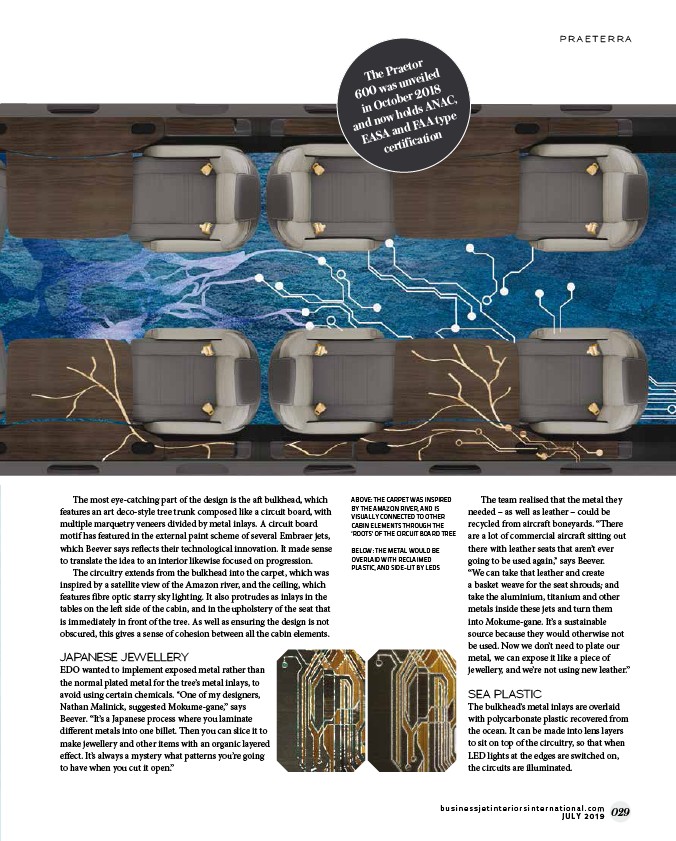
ABOVE: THE CARPET WAS INSPIRED
BY THE AMAZON RIVER, AND IS
VISUALLY CONNECTED TO OTHER
CABIN ELEMENTS THROUGH THE
‘ROOTS’ OF THE CIRCUIT BOARD TREE
BELOW: THE METAL WOULD BE
OVERLAID WITH RECLAIMED
PLASTIC, AND SIDE-LIT BY LEDS
PR A ETERRA
businessjet inter iorsinternat ional . com 029
JULY 2019
The most eye-catching part of the design is the aft bulkhead, which
features an art deco-style tree trunk composed like a circuit board, with
multiple marquetry veneers divided by metal inlays. A circuit board
motif has featured in the external paint scheme of several Embraer jets,
which Beever says reflects their technological innovation. It made sense
to translate the idea to an interior likewise focused on progression.
The circuitry extends from the bulkhead into the carpet, which was
inspired by a satellite view of the Amazon river, and the ceiling, which
features fibre optic starry sky lighting. It also protrudes as inlays in the
tables on the left side of the cabin, and in the upholstery of the seat that
is immediately in front of the tree. As well as ensuring the design is not
obscured, this gives a sense of cohesion between all the cabin elements.
JAPANESE JEWELLERY
EDO wanted to implement exposed metal rather than
the normal plated metal for the tree’s metal inlays, to
avoid using certain chemicals. “One of my designers,
Nathan Malinick, suggested Mokume-gane,” says
Beever. “It’s a Japanese process where you laminate
different metals into one billet. Then you can slice it to
make jewellery and other items with an organic layered
effect. It’s always a mystery what patterns you’re going
to have when you cut it open.”
The team realised that the metal they
needed – as well as leather – could be
recycled from aircraft boneyards. “There
are a lot of commercial aircraft sitting out
there with leather seats that aren’t ever
going to be used again,” says Beever.
“We can take that leather and create
a basket weave for the seat shrouds; and
take the aluminium, titanium and other
metals inside these jets and turn them
into Mokume-gane. It’s a sustainable
source because they would otherwise not
be used. Now we don’t need to plate our
metal, we can expose it like a piece of
jewellery, and we’re not using new leather.”
SEA PLASTIC
The bulkhead’s metal inlays are overlaid
with polycarbonate plastic recovered from
the ocean. It can be made into lens layers
to sit on top of the circuitry, so that when
LED lights at the edges are switched on,
the circuits are illuminated.
The Praetor
600 was unveiled
in October 2018
and now holds ANAC,
EASA and FAA type
certification